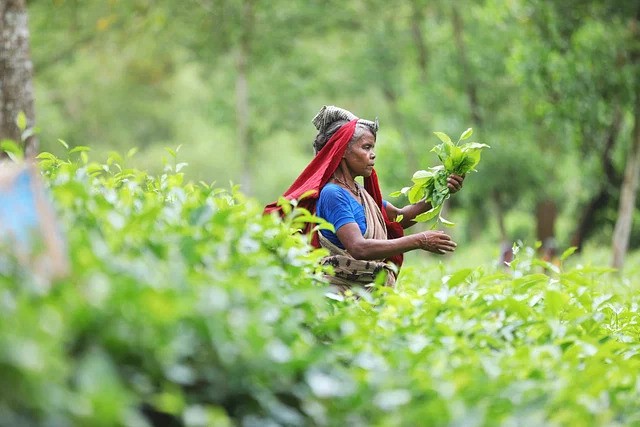Tea production: Slow start, then boom in peak season
A woman plucks tea leaves from Lakkatura tea garden in Sylhet. The picture was taken on 28 August.
| Anis Mahmud
Source: Prothom Alo
Tea production plunged because of the drought and lack of rain right at the start of the season. This gave rise to worries among the tea estate owners.
But tea production seemed to pick up momentum again in July for as the weather was favourable. Since the production increased in July despite a slow start to the season, hopefully there would be an increase in tea production this year.
According to Bangladesh Tea Board statistics, 40 million (4 crore) kilograms of tea has been produced in the country between January and July of the current year. The production was 38.3 million (3.83 crore) kilograms during the same period in 2022.
That means there has been a 4.60 per cent or 1.77 million (17.66 lakh) kilograms of growth in tea production during the months of January to July as compared to the same period last year.
Not just last year, but this is the record of highest production during the first seven months of the year so far in the history of country’s tea production.
The six months of June to November are considered the peak season of tea production. During this window, more than 10 million (1 crore) kilograms of tea is produced every month.
This year there had been less rain than normal in the tea estate areas at the start of the peak season in June. The temperature was high as well. Both these factors are harmful for tea production.
Because of such hostile weather condition, tea production dropped down to 10 million (1 crore) kilograms in June. Production in the same month last year was 12.5 million (1.25 crore).
But the production upsurge in July has been higher than that of other times. A total of 13.6 million (1.36 crore) kilograms of tea has been produced this month, which is 21 per cent higher than that of last year.
Tea production resumed the upward trend basically for the record production in a single month. The tea board has set a production target of 100 million (10 crore) kilograms this year.
Former president of tea estate owners’ organisation, Bangladesh Tea Association, Shah Alam, told Prothom Alo that the investment made in tea estates including planting new saplings on a regular basis and renovations, is bringing in returns now.
Tea production decreased at the beginning of the season due to the drought but shot up again in July, due to favourable weather condition. Meanwhile, the healthy relationship between owners and workers played a role in boosting the production. If the weather remains favourable till October, there could be record production.
If the production trend of July is sustained, it would be very possible to reach the milestone of producing 100 million (10 crore) kilograms of tea at the end of the year, he added.
Munir Ahmed, former deputy director, Bangladesh Tea Board
Better production has resulted in Bangladesh having the highest growth rate in tea production compared to the neighbouring countries. Compared to last year, production till June was hit by a 2 per cent reduction in India whereas in Sri Lanka it went up by 1 per cent.
In Kenya, production data till the month of May saw a reduction of 1 per cent. In Bangladesh on the other hand, there has been a 4.6 per cent rise of tea production till July.
Former deputy director of Bangladesh Tea Board, Munir Ahmed, who is now working as an advisor to a tea estate, told Prothom Alo Monday that tea production booms if rain follows drought. There being record production in July this year is indeed a reflection of that.
If the production trend of July is sustained, it would be very possible to reach the milestone of producing 100 million (10 crore) kilograms of tea at the end of the year, he added.
Meanwhile, tea estate owners are frustrated over the price rolling downwards at the auction despite the production boom. Records from the auction held in Chattogram showed that tea sold at Tk 205.31 per kg on average in the 17 auctions that took place this year. The price was Tk 199.22 at the same time last year. That means the price has been Tk 6 higher this year.
The growing trend of tea production is a positive sign. But it would be difficult to retain this upward trend of production if the auctions don’t come up with better prices.
Shah Alam, former president, Bangladesh Tea Association
Despite the average price being better towards the beginning a downward trend has been noticed in the last few auctions, showed the auction data. For instance, a kilogram of tea sold at Tk 190 on average in the 17th auction that was held a weak earlier. But the price had been around Tk 208 during the same time last year.
Former president of Bangladesh Tea Association Shah Alam said that the growing trend of tea production is a positive sign. But it would be difficult to retain this upward trend of production if the auctions don’t come up with better prices.
The current price rates aren’t enough to cover up the production cost and this can also throw the investments made in tea estates before a challenge, he added.
According to the tea board records, tea is being produced in seven districts of the country. These seven districts are: Moulvibazar, Habiganj, Sylhet, Chattogram, Rangamati, Bandarban and Panchagarh.
Tea is being produced in about 168 tea estates and, on a smaller scale, in the plains in these districts. A total of 93.8 million (9.38 crore) kilograms of tea had been produced on 164,000 acres of land last year.
As per tea marketing rules, tea has to be sold at auction as granules after the leaves have been plucked from the garden and then processed in the factories.









